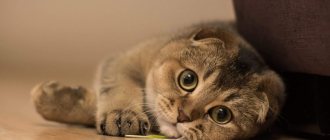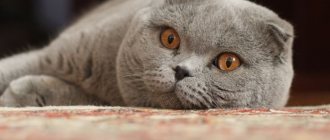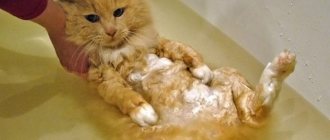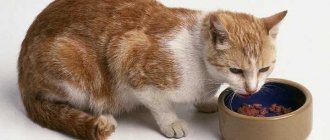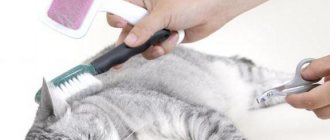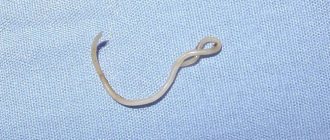Character traits
Beautiful strong muscles and bottomless blue eyes are a distinctive feature of the breed. The animal has an unusual coloring - cream, the tips of its paws are chocolate-colored, and on its face there is a dark mask and black ears. A peculiarity inherent in this variety is strabismus. Kittens are born white, but as they grow older, a unique coloring appears. Siamese kittens are short-haired pets.
If you decide to adopt this particular breed, you should carefully learn its temperament in order to be able to tame it. The Siamese cat is inquisitive, temperamental, loves to play, quickly adapts to a new home, rules and becomes attached to its owners. Gets along well with children. But you don’t need to get a small child, but you can get a kitten for a teenager. They require constant care and attention. They will meow until they get what they want. By nature, Siamese are similar to dogs; they are just as devoted to people, but they will be jealous of other animals.
If you offend a Siamese cat, he will remember for a long time and take revenge. Cats are especially dangerous and vindictive. They can attack a person at night when he is sleeping.
Health, tendency to disease
Genetic diseases:
- Amyloidosis of the liver, kidneys. The cause is a disorder of protein metabolism, which leads to chronic organ failure. Main symptoms: the animal quickly loses weight, the affected organs are enlarged. There is no treatment or prevention.
- Dilated cardiomyopathy. Characterized by expansion of the internal chambers of the heart. Leads to heart failure. It manifests itself as disturbances in the rhythm of breathing (it becomes accelerated), lethargy, poor appetite, and vomiting. Treatment is medication; if the drugs are chosen correctly, sick animals can live for several years.
- Glaucoma. Associated with increased pressure inside the eyes. It manifests itself as redness of blood vessels, clouding of the cornea, and soreness in the eyes. The eyeballs may increase in size. Consequences: retinal atrophy, blindness. Treatment: use of antiglaucoma drops.
- Congenital strabismus. Characterized by impaired three-dimensional vision due to defects in the development of the eyeball. It is important to find out if there are any serious causes (encephalitis, meningitis, inflammation of the middle ear, eyeball muscles). If they are absent, strabismus is not eliminated, as this will worsen the pet’s adaptability to the characteristics of the body.
- Hyperthyroidism is a dysfunction of the thyroid gland. Manifested by weight loss and increased appetite. Other symptoms: increased thirst, diarrhea, vomiting, difficulty breathing. Hyperthyroidism is dangerous due to the development of complications (for example, cardiovascular pathologies). Treatment: taking antithyroid drugs, surgical removal of the thyroid gland.
Preparing to maintain a home
It is necessary to create favorable conditions for the new family member. You need to take the baby away from the mother no earlier than 1 month after birth, but the later the better. Maintain the temperature at home at least 25 degrees, remove drafts, these animals love warmth. You need to buy a place where the kitten will rest. This could be a bed or a house, buy toys, because the Siamese cat is playful. Various shampoos for bathing, scissors for trimming nails, a comb for combing out fur, bowls for food and water, and a tray will come in handy. It is necessary to install at least one scratching post to protect the new wallpaper. You need to decide what to feed the animal. Remove small parts from accessible places and fence off wires.
How to choose the right kitten
In order not to be disappointed in the purchase and not to purchase a mixture of two breeds, it is better to look for a cat in certified nurseries or from trusted breeders. Before purchasing, you need to make sure you have all the necessary documents and pay attention to what the animal looks like.
The kitten must be active, moderately curious and externally meet all the requirements of the standard.
What kind of habit or character trait will appear in a mature animal can be guessed by observing the behavior of the mother cat. And the health of a little Siamese is usually judged by the absence of a swollen belly, bad breath, bald spots on the coat, discharge from the eyes, dirt under the tail and in the ears.
Kitten care
Typically, Siamese kittens reach their owners no earlier than three months of age. Therefore, owners do not have to waste time teaching them basic skills, such as using a litter box and using a scratching post.
They just have to wait until the little pet gets used to the new home and show him where his bowls, toilet and sleeping bed are located.
To prevent the Siamese kitten from becoming a victim of an accident while exploring its possessions, houseplants, household chemicals, wires and small objects are hidden from it in advance. Windows, washing machines and ovens are also kept closed in the house.
Kitten care
How often can you bathe?
Siamese cats are clean, but the owner must help. Cat care includes cleaning ears, eyes, teeth, combing fur and bathing. It is necessary to regularly inspect the ears for the presence of wax accumulation. It is recommended to wash them at least once a week with special products that are sold in veterinary pharmacies. The corners of the eyes should be wiped with a damp cotton swab moistened with saline. solution or boiled water. There are special toothpastes for animals that are used to periodically clean their teeth. Grooming does not take much time due to the lack of undercoat. Only during shedding does it need to be brushed 2 times a week. It is recommended to bathe no more than 3 times a day. in year.
Feeding
Food should be balanced and contain essential vitamins and microelements. You can feed them natural food or dry food. The kitten's diet should contain sufficient quantities of meat - beef, chicken, offal (lungs, heart, liver). They should be given boiled. You can have fish, but not often and without bones. There should always be water or milk in the bowl if the kitten wants to drink. Feed 6 times a day, reducing the number of feedings with age. Give an adult animal food 2-3 times a day. You should not give chicken and fish bones, fatty, fried, spicy, salty, chocolate and other sweets in large quantities.
The advantage of dry food is that you don’t need to decide on your own what to give in what quantity, everything is already balanced there. There are as many vitamins and microelements as needed to keep the animal active, with a healthy and shiny coat. But there is no need to waste money and choose cheap food. The following are considered useful:
Nail care
It is necessary to educate and teach to trim claws from a very early age. The procedure is carried out as it grows. To do this, it is recommended to find a quiet place where the kitten will not be distracted. The animal needs to be placed in the arms, calmed, take the paw and press on the pad. A claw will come out. You need to trim a little bit each time, vertically, so as not to touch the blood vessel. If the cat begins to worry, stop trimming. For the procedure, special scissors are used - nail clippers. After everything is over, reward the baby with a treat. He must remember that after trimming his nails there will be something tasty.
Upbringing
A correct understanding of animal psychology makes it possible to raise a kitten well from a young age. It is necessary to accustom him to the tray from childhood. This breed is endowed with intelligence, so they easily remember commands, what are “dos” and “don’ts.” If a kitten behaves badly, you should not punish, much less beat. You need to wait until he calms down and starts doing the right thing, then praise him and give him a treat. Siamese are unpretentious in maintenance and amenable to training. You can even take them out for a walk on a leash, they will react normally to this and will not mind.
Choosing a kitten, keeping, raising
Purebred kittens are bought at an exhibition, in a nursery, or a pet store. On the market, according to advertisements, cats are sometimes sold that are similar in color to Siamese. It should be borne in mind that the characteristic coloring is not yet a sign of the breed. Before purchasing, it is advisable to examine the baby’s parents, paying attention to appearance and behavior.
If you need a Siamese to participate in exhibitions, choose a show-class kitten that meets the breed standards. They are not cheap. Prices for breeding class animals will be lower. The category includes individuals for breeding that have slight deviations from the standards.
Pet class kittens are relatively inexpensive. Due to disqualifying defects, they cannot take part in exhibitions or breeding. Pay attention to appearance:
- The vertebrae and ribs should not protrude (a sign of exhaustion);
- no tumors, lumps (symptoms of cardiovascular diseases, cancer, presence of parasites);
- no skin damage, bald patches;
- no discharge from the ears, eyes, nose, anus;
- no gait disturbances;
- the fur is shiny, smooth;
- the eyes are clean, the teeth are even white, the gums are pale pink;
- The kitten is active, active and friendly.
It is not recommended to choose a baby who shows aggression (scratching, biting, hissing) or, conversely, who is indecisive and timid. There will be problems with taming in the future.
Content
The recommended temperature is 25-28 °C, drafts and dampness are excluded. During the cold season, place a heater near the kitten's resting place. The bedding should be warm. You can put a heating pad by wrapping it in a towel. A comfortable temperature regime is important for preserving the color of Siamese cats.
Prepare a tray with filler, bowls for food, and water. Place bowls away from the toilet. Siamese will not eat where they relieve themselves. The tray should be in a secluded place. Change the litter in a timely manner; if the toilet is dirty, the cat will “do the job” in another place.
Place small objects, household chemicals, and wires out of reach. To prevent your kitten from spoiling indoor flowers, grow catnip and grass, they are sold in pet stores. Do not let your older pet go outside alone if you live in an apartment. Siamese do well in confined spaces if given enough attention.
Give anthelmintic drugs regularly (1 dose every 3 months). Vaccination schedule:
- At the age of 12 weeks - a vaccine against rhinotracheitis, rabies, panleukopenia, calcivirosis. Revaccination - after 3-4 weeks, then 1 r. per year, during the same period.
- At the age of 1-6 months. – vaccination against microsporia, trichophytosis. Revaccination - after 2 weeks, once a year.
Features of education
At first, do not leave the kitten alone for a long time, this way it will quickly adapt to the house and its owner. Give your pet enough time. Please note that at the age of 2-5 months. In animals, areas of the brain responsible for mental development are actively developing, incl. for social behavior.
How to behave towards a Siamese: respectful, be patient, persistent, feel the animal’s mood. The only method of influencing the psyche is affection; physical punishment is excluded.
The kitten will quickly get used to its name and the routine in the house. He should act friendly and calm. To prevent the kitten from showing aggression during grooming procedures, accustom it to touch from the first days of life in the house. Take the baby in your arms, stroke the fur, talk affectionately. The process may take several weeks.
Accustoming your pet to a scratching post and litter tray is not difficult. Siamese are quite trainable; they can be taught:
- walk on a harness (leash);
- give paw;
- follow the commands “sit”, “lie down”, etc.;
- bring items;
- jump over a barrier, etc.
The kitten should have toys: ping-pong balls, spools of thread, an ordinary sock stuffed with rags and rolled into a ball.
Siamese are prone to destructive behavior, which is difficult to influence. Just don't leave clothes or any other objects within the animal's reach. One of the possible causes of aggression is lack of attention; you need to regularly communicate and play with your pet. The optimal solution to the problem is keeping 2 cats.
Nutrition and care of Siamese cats
Siamese are picky eaters and fickle in their tastes.
Siamese often love to eat unexpected foods: nuts, corn, mushrooms, sweets, fruits. When feeding natural foods, ensure variety and remember that a meat diet causes darkening of the coat in Siamese cats. It will be better if at least 30% of the diet comes from fish. When feeding with ready-made food, feed only food from well-known manufacturers of premium, superpremium or medium class - “Yams”, “Hills”, “Boi” and others. Make sure your cat always has access to water. Siamese drink a lot, preferring running or settled fresh water. They are picky about their water container. Some prefer the owner's bowl, others require water to be poured into a bucket (for some reason, many Siamese suffer from gigantism disease), others drink only water flowing from the tap. Always make sure that the water is not cold, as Siamese are prone to colds.
How to monitor your pet's health
Congenital diseases of Siamese are protrusion of the sternum, creases in the tail, and strabismus.
Siamese cats are also susceptible to bronchitis, so it is important to keep them warm. Liver diseases are also possible, but they are primarily associated with poor diet. Cats often develop dental problems. In addition, males are at risk of developing cardiomyopathy, and cats develop mammary tumors.
Animals are vaccinated to maintain normal health. Usually vaccinations are given from 12 weeks, but if the mother is not vaccinated, kittens are vaccinated as early as 8 weeks.
Vaccinations are performed only by veterinarians who will schedule them. In no case should kittens be vaccinated during the period of teeth change, which can negatively affect their health, or pregnant cats should be vaccinated. Before vaccination (10 days before), animals are freed from parasites.
Appearance of a Siamese kitten
The head is narrow, with a long, narrow muzzle, a massive chin, and a straight nose. The skull is distinguished by its flatness. The eyes are bright blue (a green tint is considered a deviation from the standards), almond-shaped and slightly convex, small in size. They are positioned somewhat obliquely towards the nose. Large triangular ears spread to the sides. The body is elongated and proportionate, the belly is tucked, ending in long slender legs, the front ones being slightly shorter than the long ones. The tail, thin and long, is pointed at the tip. Weight is small, 3-4 kg.
Breed standard according to the World Cat Federation system
| Body |
|
| Head |
|
| Ears |
|
| Eyes |
|
| Tail |
|
| Wool |
|
| Color |
|
| Flaws |
|
How are Siamese kittens born?
You will be surprised, but they are white. Only the nose and pads have a pink tint. Then the fur darkens. This happens at 2 weeks of age. The lower the room temperature, the darker the shade of the cover. Siamese kittens, born and constantly living outdoors, are almost brown at the first molt, the color of the stripes is black. And mustaches that live in warm conditions are cream or creamy beige in color with chocolate markings. The coat is not long, there will be no problems with its care and cleaning - 15 minutes of combing a day will be quite enough. Independent Siamese are characterized by pronounced hunter instincts and by no means a diplomatic oriental temperament.
Sometimes they show stubbornness and jealousy. At the same time, they become strongly attached to their owner and love children. And they are wary of strangers and other pets. Siamese kittens have excellent intelligence, are highly intelligent, are able to capture not only the tone, but also the shade of speech, they do not like to be criticized and are offended for a long time. Regarding the peculiarities, they note that long fingers allow pets of this breed to skillfully use them for “criminal purposes,” for example, opening doors and cabinets, unzipping a bag or similar locks.
Breed Features
Why do Siamese have such a strange color - with dark markings? | This is a genetic feature of the breed; the color of the coat will depend on body temperature. Kittens are born without marks (points), which appear only after a few weeks. The darkest fur will be in the coldest points of the body: ears, nose, tail, limbs. A Siamese living in a warm environment will have a lighter color. The shade stabilizes by 1-2 years; the coat darkens with age. |
Is it true that Siamese are evil? | Character will depend on upbringing. If a pet grows up in an atmosphere of love and tranquility, it will not become evil. However, Siamese are distinguished by their vindictiveness and do not forgive humiliation, so they can show aggression towards the offender. |
Who is best suited for Siamese cats? | Active, sociable people who can devote enough time and attention to their pet. |
How do Siamese treat children? | The Siamese cat easily gets along with active children and willingly participates in games. However, you need to explain to the child that you cannot squeeze or touch her tail. Siamese are not suitable for the role of a living toy; if handled carelessly, they can use their claws and teeth. A child can be taught to care for a pet: feed it, change the water. This will improve relationships. |
Who is better to choose: a cat or a female cat? | Siamese cats have a more attractive appearance because they are larger. They are easier to care for. Kitties are calmer, more affectionate, sensitive, and very attached to their owner. |
Are Siamese cats fluffy? | According to the standard, Siamese must have short hair. Representatives of the Balinese breed (a type of Siamese) are semi-longhaired. They differ from Siamese by having long hair without undercoat and a balanced, somewhat melancholy character. |
A two-month-old Siamese kitten’s tail seems to be broken in 2 places and is growing in the shape of the letter “g”, what should I do? | This phenomenon occurs quite often among Siamese. Previously, this was considered a sign of purebred, but in fact it is a defect in the exterior. This does not affect health, but such animals are not allowed for breeding. |
Do Siamese have short tails? | No, according to the standard, purebred animals must have a whip-shaped, very long tail. Cats with a Siamese (point) color, but with a short tail, belong to the “Thai (Mekong) Bobtail” breed. |
How much will a purebred kitten cost? | This depends on several factors: the presence of a pedigree, parents imported from abroad or winners of exhibitions, and the reputation of the nursery. Pet-class kittens (for home), on average, cost 10-15 thousand rubles, breeding class (pedigree) - from 600 dollars, show class (exhibition) - from 800 dollars. and higher. |
Advantages
- They have an elegant, attractive appearance.
- Loving, devoted, sociable.
- Smart and quick-witted, easy to train.
- You can quickly train him to walk on a harness.
- They adapt perfectly to the lifestyle of their household.
- Very energetic and active, they can be an excellent playmate for children.
- Clean, do not require special care.
- Born hunters.
- They have good health and can live quite a long time - up to 15-20 years. The Guinness Book of Records records a case where a Siamese lived for 38 years.
Flaws
- They require a special approach to education; if treated incorrectly, they can become aggressive.
- Willful, stubborn.
- They are very vulnerable, remember insults for a long time, and can take revenge without forgiving punishment without guilt.
- They are prone to destructive behavior (they often become the culprits of severe disorder in the house).
- They do not tolerate loneliness well and need to pay a lot of attention.
- If a cat doesn’t like something, it howls long and shrilly.
- A loud voice becomes a problem when in heat.
- It is necessary to keep warm, as Siamese have no undercoat.
Choosing between a girl and a boy pet
... many give preference to the latter, considering it more beautiful and less troublesome. Perhaps this is more correct, cats are very independent, creating an image for themselves as the owner of the house. The owners are considered servants; their character is curious, active, and at times irritable and aggressive. Cats are much calmer and more affectionate, more loyal and clean. However, there are always exceptions to the rules.
While their owners are away from home, smart cats will happily play with puzzle toys or spend time in a playhouse or a vertical sports complex. A nail sharpener is on the shopping list for pets so they don't scratch their claws on anything. Another pet companion, not necessarily a cat, can also help relieve boredom.
How to name?
If you cannot decide what to name a Siamese kitten, then we bring to your attention the following names for a boy: Athos, Venya, Perchik, Nelson, Everet, Gordon, Pearl, Onyx, Mathias. Suitable nicknames for the girl are: Buffy, Toffee, Stephie, Shoko, Christel, Melanie, Walesi, Sukki.
The origin of the Siamese cat breed is surrounded by many legends, going back almost to the time of Noah’s flood. According to one hypothesis, a male monkey and a lioness on the Old Testament ark fell in love with each other, and as a result of this, a representative of the Siamese breed appeared.
A more realistic version calls the birthplace of Siamese kittens Thailand, previously Siam. Cats, considered guides to the other world, enjoyed special respect and were kept exclusively in royal families or monasteries. The export of kittens from the territory of the state was strictly prohibited. The kittens were brought to Europe to Queen Victoria at the end of the 19th century. She liked them so much that, thanks to her personal sympathy, the popularity of the Siamese increased greatly. centuries, cats came to Europe.
Siamese cat breed
Thailand, in ancient times called Siam, is the birthplace of Siamese cats.
Their history begins in the 14th century. and goes back many centuries. Residents of the country called cats “moon diamonds.” These were sacred animals that were found only in royal families and monks. Their export outside the country was prohibited, so in American and European territory they knew nothing about this breed.
The cat was first seen in Europe in 1871, during the Crystal Palace Cat Show.
She appeared as a pet in 1878 in the family of President Rutherford B. Hayes. It was a gift to his wife from American diplomat David B. Sickels, who brought the animal from Thailand.
The unusual appearance of Siamese cats did not immediately appeal to Europeans. But today the breed is at the peak of popularity. This pet is characterized by grace and majesty.
The Fold cat is a mixture of 2 different breeds. In character and habits it is similar to the Siamese. Differences include angled ears and slightly puffy fur.
Standard
Pet breeds are often confused, so you should know what a Siamese cat looks like:
- slender, elongated body with pronounced muscles;
- wedge-shaped head (the wedge originates at the tip of the nose and widens towards the ears);
- narrow muzzle;
- Long neck;
- the ears are large, continue the wedge of the head, they are wider at the base, narrowed towards the tips;
- long straight nose;
- almond-shaped blue eyes set at a slight angle;
- long limbs, forelimbs shorter than hind limbs;
- oval-shaped paws;
- thin tail, long and flexible, pointed at the tip;
- short, silky and glossy coat, lying close to the body, no undercoat;
- The color is represented by 20 species, but all Siamese have spots (points) that are darker than the main color on the face, paws, ears and tail;
- weight 3-6 kg;
- height at withers 23-25 cm;
- lives 14-25 years.
The Siamese cat is very different in appearance from the Thai cat.
Kittens of this breed are born white and change color unevenly as they grow older. In areas of the body with low temperatures, the coat is darker.
Varieties of colors of Siamese cats:
- Blue point. Snow-white fur, paws, ears, tail and muzzle are cast in blue.
- Seal point. Light brown or cream coat, points have a rich dark brown tint.
- Red point. White fur interspersed with red, apricot or reddish spots.
- Caramel point. Matching shade with pink-grey points.
- Lilac Point. White body with gray fragments, there is a slight pinkish tint.
- Cinnamon Point. Ivory color with pink-brown flecks.
- Chocolate point. The same color, but with chocolate markings; in some individuals the spots are almost black.
The color depends on the region of residence. In the northern regions, the spots on the coat are darker. The color is finally formed at 6-9 months, but if the animal lives in colder climatic conditions, then even an adult may darken.
Siamese cats are able to be friends with each other.
Advantages and disadvantages
Before deciding whether or not to get a Siamese, you should study its advantages and disadvantages.
Pros:
- smart;
- devotees;
- easy to train;
- graceful;
- beautiful;
- get along easily with children;
- love to play;
- practically do not shed.
On the right is a Siamese cat called Thai, on the left is a Siamese cat of Liliak Point color.
Of the minuses:
- thermophilic, do not tolerate low temperatures;
- vindictive;
- touchy;
- wayward;
- independent;
- clean;
- they like to “talk”, while they have a loud voice;
- jealous, do not tolerate the presence of other pets in the house.
The Siamese cat is native to Siam (present-day Thailand). In this state it was considered sacred and protected by law. Taking these cats out of the country was strictly prohibited. Each representative of the royal dynasty had a Siamese, and even during a ceremony such as coronation, they were allocated a separate carriage for transportation.
As the story goes, the heirs to the throne had their only friend and companion - a Siamese cat. “Moon Diamond” is the name of the animal in Thai. The first Siamese cat was brought to England in 1871, where it was presented at an exhibition. Local residents greeted this animal without enthusiasm.
Siamese cats are easy to train and are able to remember some commands.
The first title, “Cat of Nightmares,” speaks for itself. Over time, people appreciated the beauty and features of the animal. In 1902, the British founded a club for lovers of these cats. Around the same time, the Siamese cat appeared in Russia.
The Siamese cat came to the United States as a gift to President Rutherford Burchard Hayes. Philip, Duke of Edinburgh presented it to Elizabeth II on her wedding day. These days, the Siamese cat breed is the third most popular breed in the world.
Siamese can be found in every corner of the globe. The greatest interest in them was shown in the middle of the twentieth century. Modern Siamese cats differ significantly from their ancestors, who were distinguished by their large heads and heavy bodies.
The work of breeders has introduced some changes. Now the Siamese has a graceful body with a small, triangular-shaped head. The color range of animals is constantly expanding. The International Felinological Organization has recognized four colors of Siamese:
- Lilac-point (the predominant body color is magnolia, paws, muzzle and ears are gray-blue with a pink tint).
- Blue point (the predominant body color is fawn-gray, paws, muzzle and ears are gray-blue).
- Seal point (predominant body color is cream, paws, muzzle and ears are dark brown).
- Chocolate – point (the predominant body color is ivory, paws, muzzle and ears are milk chocolate). This color is the most popular.
Albino Siamese cats are called blondenes. Other colors of Siamese cats have earned recognition in other organizations.
- Torty point. The wool on the points is colored in three colors.
- Tubby point. The color of the points contains stripes.
Typically, Siamese cat kittens are born with pure white fur. They do not have any shades or spots. After a month and a half, the first spots appear on the babies. Only at one year of age do cats acquire their final coat color.
According to its description, the Siamese cat is an elegant animal with a muscular body of medium size. Has great flexibility. Long legs - slender and graceful. The tail, pointed at the tip, resembles a whip. The animal's head resembles a wedge, starting from the nose and diverging in straight lines to the ears. The ears are large, wide at the head with pointed tips.
The eyes of a Siamese cat are almond-shaped. They can be bulging or, conversely, deeply planted. Many representatives have strabismus at the genetic level. Eye color can be either blue or green. Some Siamese have multi-colored eyes.
The coat is short, silky, with a characteristic shine. Fits tightly to the body. There is no undercoat. There are also long-haired, fluffy Siamese cats, these are Balinese cats. Now the breed is divided into two subspecies.
The classics include animals with a muscular, well-built body. The eyes and ears are not very large. Others are slender and have a long body. The muzzle is elongated. The ears are large, pointed towards the top. Long tail and slanted eyes.
Strabismus is not uncommon among Siamese cats.
| Body |
|
| Head |
|
| Ears |
|
| Eyes |
|
| Tail |
|
| Wool |
|
| Color |
|
| Flaws |
|
We suggest you read: What to feed a castrated cat with natural food. Feeding a cat after castration: features of natural and industrial nutrition
Caring for a Siamese kitten
It is simple due to the short hair and the love of cleanliness of animals of this breed; in addition to combing, take care of the eyes and ears by wiping them daily with a cotton pad soaked in Vaseline oil (for ear care) or in water (for the eyes).
Teeth are a pet’s weak point; weekly care in the form of brushing teeth and treating them with a special treat will make it easier.
The love of drinking (as opposed to swimming and water procedures) is in the blood of Siamese representatives; use a bowl with a wide bottom or a special automatic fountain drinker. Leave the food only in the amount that will be enough for one meal, wash the empty bowl with hot water before the next filling, and discuss regular food with your veterinarian. The tray also needs to be cleaned after the “hike”.
Siamese kittens are very popular and therefore widespread. If you are interested in the price, then Avito offers to buy kittens almost for nothing or free of charge “in good hands.” It is better to purchase a kitten with a pedigree from a nursery. Here their cost (based on data from Moscow nurseries) is from 15 to 25 thousand rubles, in the regions it is cheaper - 7-15 thousand.
What living conditions do Siamese cats require?
Representatives of this breed are active, agile and curious. Therefore, it is advisable to equip your pet with a play complex with high shelves and posts on which he can climb and jump. This way the Siamese cat will be able to give out its energy and will not get bored. Although inquisitive animals will not leave any corner of your home unattended.
Siamese cats will also willingly play with different mice, balls and other toys. Even a simple piece of paper on a string can captivate them and make them show off all their hunting skills.
Siamese cats are curious and watch with interest everything that happens around them. Photo: TalyaPhoto / Shutterctock
You won't be able to do it without a scratching post. The Siamese cat will be able to sharpen its claws on it, which means it will not show interest in your furniture and wallpaper.
In addition to a variety of leisure activities, take care of the safety of your pet. To do this, it is best to put special nets on the windows. They will protect the cat from falling if she gets carried away and decides to hunt birds or flying leaves. Protection can be installed even on the windows of first-floor apartments.
Of course, a fall from such a small height does not cause serious consequences. But an animal that finds itself in an unfamiliar environment for the first time may become frightened and run away or be harmed by dogs and other people’s cats.
Reviews
Reviews about pets are very different, but even negative ones cannot consider Siamese angry, vindictive or excessively aggressive. Experts believe that earlier, when kinks or bends in the tail were considered a point of the breed, the nerve endings were simultaneously pinched and the vertebrae were bent. The kitty felt constant pain and discomfort, so she was not inclined to tenderness or affection.
Owners described their Siamese kittens as “incredibly smart,” “the most affectionate creatures,” using the “toilet like a human,” able to accept training techniques, and playful and active friends with “the mother-in-law and the German shepherd.” Among the disadvantages, they noted loudness and excessive purring, jealousy, the requirement of absolute hygiene, vindictiveness, touchiness, and willfulness. Get such a pet and form your opinion about its character and personality.
Reviews from Siamese cat owners
Despite their slightly mischievous nature, many owners respond positively to the Siamese breed.
“Before buying a Siamese kitten, the breeder told me that the character of the animal very much depends on its color. In practice, I realized that this is not so. My friend has a blue point, I have a caramel, but both cats are very temperamental. It is immediately obvious that royal blood flows in their veins. Despite this, I am satisfied with my favorite. Although sometimes she shows her steadfastness, but mostly she is a sweet and gentle creature who asks for mutual love.”
“I would like to point out that Siamese cats are indeed very voracious. I scream all the time, no matter how much I don’t let her eat. But you have to feed him and then walk him on a leash for several hours to avoid obesity. These cats are impatient and allow themselves to be petted and kneaded only when the mood strikes them. Mostly they try to find privacy, but every time I come home from work, my cat is faithfully waiting for me at the door. How can you not love her for this?”
“I’m very pleased that I chose the Siamese, she is loyal, gentle and very witty. She quickly learned all the house rules, she doesn’t climb on the table, and only gets into bed after I invite her with a gesture. Mostly he lies obediently in his bed. For some time I tried to wean her from sharpening her claws on the sofa, the cat did not recognize the scratching post, but now she can use it for her needs. She’s a little loud and loud, but that’s her nature, so you have to put up with it.”
Education University: Moscow State Academy of Veterinary Medicine. Year of graduation: 2010. Specialty: Veterinary medicine, Veterinary medicine. Experience I have experience working in a veterinary clinic for more than 7 years. Experience of the Federal State Budgetary Institution "All-Russian State Center for Quality and Standardization of Medicines for Animals and Feed"
Briefly about the breed
The breed standard was adopted after World War II.
According to him, the Siamese cat breed has the following characteristics:
- small size;
- the body is long, thin, graceful;
- the head is small, wedge-shaped, the muzzle is graceful, with a clear profile;
- legs long, thin, high-set, hind legs longer;
- the ears are set wide apart, wide at the base, sharp at the ends;
- eyes slightly slanted, exclusively blue;
- the tail is long, smooth, with a sharp tip;
- the coat is short, soft, lying close to the body;
- characteristic color (point).
The historical (royal) color is considered the main color. It is characterized by a light, often cream or beige, color with dark brown markings on the face, ears, paws and tail. But at exhibitions it is no longer uncommon to see cats of black, blue, silver, and lilac colors. Instances of complex, multi-colored colors appeared. Although many felinological organizations do not recognize colors other than truly royal ones.
Dark markings are associated with the anatomy of the breed. The pigment level of Siamese directly depends on the temperature of the body area and even the habitat. The colder the area of the body, the more pigment in the hair and the darker it is. Therefore, the paws, ears, muzzle and tail of the Siamese cat are darker. Although Siamese kittens are born an even light shade, the markings appear by 10 months. Moreover, if you keep your cat warm, its coat will become lighter in adulthood.
Strabismus and tail creases, previously considered the main characteristics of the breed, are now classified as defects.
A Siamese cat with such defects is not allowed for breeding or for exhibitions.
For full development, the Siamese cat needs movement and games. Radio-controlled toys are very suitable - they will help realize hunting instincts. Cats can play for hours, and it is a mesmerizingly beautiful sight. Most of those who have a Siamese cat post dozens of photos of their pets’ games on their pages, and each photo emphasizes the inimitable plasticity of the Siamese.
The short coat and thick undercoat are easy to care for; just brush them once a week with a brush. Wash your cat no more than 2 times a year.
Particular attention to the eyes and ears. They need to be cleared of secretions, and the ears are instilled for prevention. If the discharge is excessive, contact your veterinarian immediately.
Siamese are prone to dental problems, so make sure you buy cat toothpaste, cotton pads, bone brushes, and special toys.
Claws should also be treated. To do this, it is enough to cut them by 2 mm once every 2 weeks, and buy a scratching post.
What to look for when buying a Siamese cat
The price of a future pet is influenced by a number of factors, with one of the main ones being its class. For example, animals that belong to the “show” class are not cheap, but they meet the breed standards as closely as possible and they have all the data to become winners and prize-winners of exhibitions.
“Breed” is the best option for those who plan to breed and expect to get worthy offspring. Well, the “pet” class is animals for the soul, which will become excellent pets and, moreover, you will get at a more affordable price.
Pet health is another important aspect that cannot be ignored. Be sure to take a closer look at the kitten before purchasing. He should be mobile, active and well-fed, playful, but not aggressive. Please also pay attention to the conditions of its detention. Also, be sure to ask whether all vaccinations required by age have been completed.
And finally, documents. Together with the kitten, you must receive a purchase and sale agreement, a veterinary passport with vaccination notes, as well as a metric, based on which you can then obtain a pedigree.
When buying a Siamese cat without any documents, first of all, get her a veterinary passport and consult with a specialist about vaccinations. As for the pedigree, there is no way to register it for such a kitten.
Smart girl with character
Even the most notorious skeptics recognize the intelligence of the Siamese cat. Moreover, some of their habits are similar to those of dogs: they love to carry balls in their teeth, they can fetch slippers, they calmly walk on a harness with a leash, they follow the command “Sit!” The cat will do all this if the owner treats her attentively and fairly. It is not recommended to offend these cats; their intelligence and enviable memory will help them take revenge. So punishment should only be for really bad behavior.
But the Siamese cat is an excellent conversationalist. She does not squint while talking, her blue piercing eyes do not let go of your gaze.
A cat with such intelligence is capable of blackmail. She will quickly learn that her shrillest voice among cats will always help you get what you want. And he will scream annoyingly until he gets his way.
But if harmony is achieved in the relationship with the owner, the Siamese cat pays with strong affection. She stands up for “her” person and rushes to his defense without delay. The cat's dislike of disorder and noise keeps the owner in good shape.
The cat has a proud and independent character. In case of conflict, she will easily “show her claw.” Does not tolerate squeezing. With other pets, he remains neutral until they try to dominate. They are very patient with children, even caring, but also within certain limits. The Siamese will not allow itself to be pulled by its tail or whiskers.
This unusual manner of demeanor leaves no undertones in the relationship. You can either adore the Siamese cat or not recognize it. Those who let her into their hearts remain faithful to the breed forever. It’s no wonder that the online tag “Siamese kittens photos” remains very popular. The understanding and soulful look of slightly slanted eyes on a chocolate face can conquer any heart.
Colors of Siamese cats with photos
The Siamese cat, whether fluffy or short-haired, has another interesting feature - it changes color and its saturation under the influence of temperature changes. A cool environment often causes a noticeable darkening of the color. The optimal temperature at which the natural shade will appear is 25-28 0 C.
However, there are more than 20 variations of points (characteristic markings of the color of the face, ears and paws) of the Siamese cat. Let's consider the main ones:
- Siamese cat photo chocolate point color.
- Siamese cats photos of red point and seal point shades.
